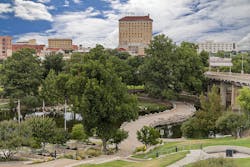San Angelo, Texas, Wastewater Plant to Become a Water Source
The Concho River Water Project “is a move to extend San Angelo’s sources beyond its lakes and the Hickory Aquifer,” according to a city news release.
“It will do so by adding a reliable and sustainable source that will help meet water needs for decades to come.” The source in this case being the city’s wastewater treatment plant. San Angelo, Texas, officials released the details of the plan on Tuesday, Oct. 2.
According to San Angelo Standard-Times, “highly treated” water from the wastewater treatment plant would be released into the Concho River, mixing with the river’s water before being “recouped farther downstream and piped to the water treatment plant, where it will be treated to drinking standards.”
The city council “unanimously agreed to pursue state permits that will ensure the water is treated to adequately high standards before its release into the river.”
Sending treated wastewater into the river before the water treatment plant is meant to provide “an environmental buffer,” said Scott Hibbs, principal water resource engineer with Abilene engineering firm eHT. “So we’re letting Mother Nature take care of some of the treatment aspects.”
The press release states officials recommended the Concho River project after studying two dozen alternatives, including surface water, groundwater and direct potable reuse options.
They also said the Concho River Water Project is a reliable and cost-effective source, will produce water with an improved taste, can be developed relatively quickly, and utilizes proven science.
Cities have released their treated wastewater downstream into streams, river and lakes. Treated wastewater from Ballinger, Robert Lee and Winters flows into San Angelo’s primary water source, Ivie Reservoir.
The project could be implemented in about five years for about $120 million. The process would include securing permits and upgrading the water and wastewater treatment plants. Improvement that “would be needed regardless of which new water source was chosen,” the release states.
San Angelo uses about 12 million gal of water per day (mgd). The Hickory Aquifer is capable of producing 8 mgd and is being expanded to 12 mgd.
Officials say the new project “will help meet local water demands for about the next 50 years.” The city’s West Texas Water Partnership with Abilene and Midland will continue seeking long-term sources.
